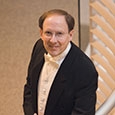.jpg)
Recognized as one of his most stirring and unique compositions, The Footlifter March, appropriately titled by the Cincinnati-born composer, inspires audience members to tap their feet enthusiastically and grin from ear to ear whenever it is performed. It was composed in just four days at the start of the Great Depression, at the request of an unknown Cincinnati business owner, probably of an insurance company, for advertising on the city’s WLW radio. The 1999 Carl Fischer edition (copyrighted in 2003) by Robert E. Foster, complete with a full score, is a favorite of bands and audiences whenever it is programmed.
According to those close to the composer, his preferred tempo for this alla breve march in 6/8 is dotted quarter = 144. The march is based on the standard ABC march form, but Fillmore omits an introduction altogether, instead beginning on the first strain. Also, instead of launching into the fight or break strain with the typical blazing trombones, he devotes it exclusively to the percussion section playing somewhat of a Memorial Day- or Fourth of July-style parade street beat. Otherwise, Fillmore uses a symmetrical form with the first, second, and fight strains each consisting of 16 bars, and the trio and trio recapitulation doubling that to 32 bars each.
To achieve the intended separated march style, Robert E. Foster recommends that all notes not slurred or marked legato should be separated and that all accented notes should also be separated. To further emphasize the needed separation in marches, Colonel Lowell E. Graham, former conductor of the United States Air Force Band, suggests treating all dots in dotted rhythm passages as rests. Hence, a dotted half note is played as a half note followed by a quarter rest, and a dotted quarter note is performed as a quarter note followed by an eighth rest. Keith Brion, noted Sousa impersonator, scholar, and founder/conductor of the New Sousa Band, suggests that the overall interpretive style of the early twentieth century be adopted in the performance practices of all music of the era, including marches. In his landmark text, Sousa’s Marches – As He Performed Them, Brion recommends that all long notes should be played stronger or louder, all short notes should be played softer, and all accidentals should be accented.
As with almost all marches, one of the biggest temptations for student musicians is needlessly slowing the tempo at the trio. The use of an amplified metronome during rehearsal usually helps students to keep the tempo consistent. David Kish, Director of Bands at Metropolitan State University, offers another effective technique towards this end. Before even having students sightread any problem passage, he suggests having them finger click or air tongue their rhythms in that section several times with the metronome. Getting that steady tempo embedded in their heads even before students play often helps to prevent dragging.
Concerning conducting two-beat patterns in 6/8 meter, Keith Brion states that “the up and down pattern in the conducting books for conducting 6/8 marches can be deadly, because the natural rebounds of that textbook gesture, a reverse J, tend to emphasize subdivisions that are duple rather than triple . . . i.e. visually representing 2/4 rather than 6/8.” To achieve more accurate rhythmic clarity in compound duple meter, he suggests the following conducting pattern options:
• The Smile, a side-to-side motion in which the beat appears at the bottom while the rebound comes on the third and sixth beats of the subdivision, “the corners of the smile.”
• The Straight Line, a variation on the smile which is a simple side-to-side, or straight-line, a technique often used by the late Frederick Fennell.
• The Frown, which is simply an upside down smile.
The percussion parts in the Foster edition consist of the usual snare drum, bass drum, crash cymbals, and bells, but no timpani, which is typical of the Sousa/Fillmore/King-era march tradition. Conductors should consider using two snare drums, one larger and deeper in sound than the other, and played in an open or double bounced style throughout. Cutting down to one snare drum at the trio at 35 is advised with the partnering snare returning for the trio recapitulation at 67.
To produce the desired resonance, be sure the bass drum is played a few inches from the center of the drum head and not in the dead center, which generally produces a rather abrasive and hollow sound. In the performance of most marches, both Robert E. Foster, and John Philip Sousa recommend that the typical tonic-dominant bass line usually found in the low woodwinds, tubas, and bass drum place a slight emphasis on the downbeat of each measure to add musical direction and avoid the often monotonous ongoing thud on every beat.
Fennell in his 1998 Dallas Wind Symphony recording, Marches I’ve Missed, suggests cutting measures 110-113 of the percussion fight strain. This small change gratifyingly surprises the listener by breaking up the somewhat hypnotic symmetrical phrases up to that point. If this idea is adopted, remember to change the number of measures rest at 99 in the tubas and bells from 16 to 12 and in all remaining woodwind and brass parts from 15 to 11. To further pronounce the abrupt end of the fight strain, consider adding both a crash cymbal crash and a simultaneous suspended cymbal crash along with the accented bass drum on the downbeat at 114.
As is generally recommended in the performance of all marches, the addition of meticulously placed accents in the crash cymbals and bass drum contribute to the liveliness and character of the music. In the same above recording, in addition to the appropriate accents notated in the Foster edition, Fennell also suggests adding a ffz accent in the trio recapitulation on the downbeat at 82 along with the previously mentioned one added at 114.
Finally, remind students that the concluding accented stinger is actually an Eb major triad. Make sure it is balanced so that the chord can easily be recognized, keeping it short, but not clipped.
The “happy music” moniker often attributed to Henry Fillmore accurately and affectionately describes the nature of his over 200 works for band. To that end, he was truly a people’s musician and his Footlifter March is sure to add sparkle to every concert on which it is programmed. Because it leaps directly into the first strain, this cheerful little masterpiece might also make a wonderfully effective and seemingly spontaneous encore number at the end of a summer evening pops concert in the park.
After successfully conducting the Syrian Temple Shriner Band out of Cincinnati to repeated national championships, he formed and conducted his professional Fillmore Band. This outstanding ensemble had a weekly radio program that often featured his dog Mike (as in the abbreviation for microphone), who he had trained to bark on cue. In addition to being recognized as the father of the trombone smear for his many trombone novelty compositions, Uncle Henry (as he was affectionately known in the Florida high school band rooms he frequented) was both a remarkable march composer and an animated and often hilarious showman on the podium.






